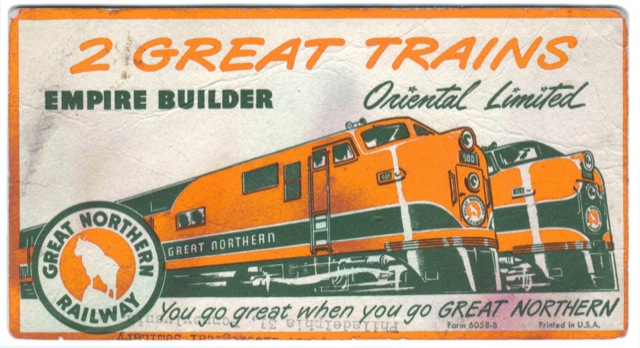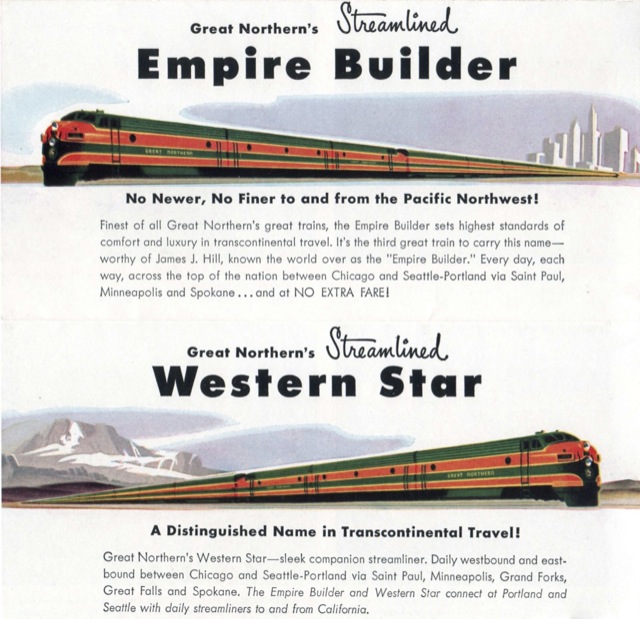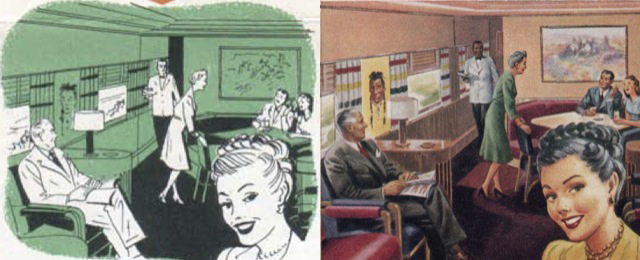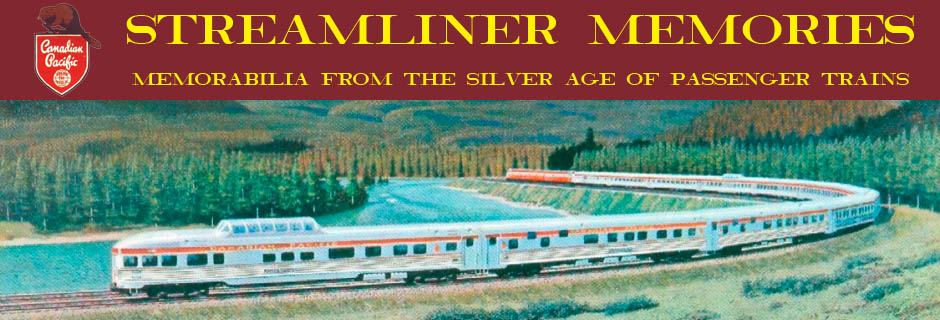When the Great Northern purchased equipment for a second transcontinental streamliner, it decided to retire the name Oriental Limited. This had been the railway’s premiere train from 1905 to 1929 and its secondary transcontinental from 1929 to 1931, when it was cut due to the Depression, and from 1946 to 1951. To name the new secondary streamliner, the railway held a “name-the-train” contest in 1950.

And the winning entry in the contest was . . . the Evergreen! That name was good enough to earn the contestant a prize, but apparently not good enough to actually use, as the GN instead named the “new” train the Western Star. Note that the train’s logo uses a five-pointed star with two points hollowed out so that it does dual-service as an arrowhead.

Click to download a PDF of this blotter.
In 1947, when the GN introduced its streamlined Empire Builder, the railroad often advertised the Empire Builder and Oriental Limited together under the slogan, “Two Great Trains.” With the introduction of the streamlined Western Star, the railroad would use this theme repeatedly in magazine advertisements and brochures.

Click to download a 6.0-MG PDF of this brochure about Great Northern’s streamlined trains.
The Western Star part of this “Two Great Trains” brochure used many of the same graphics that had been used to advertise the 1947 Empire Builder. Compare below the two-color graphic on the left, which from the New Empire Builder brochure, with the four-color graphic on the right from the Two Great Trains brochure. I suspect the four-color graphic was used in Empire Builder brochures that I don’t have. The two graphics show the interior of the observation car, with a Charlie Russell painting (identifiable as “Desperate Stand”) on the right and a Winold Reiss painting (identifiable as “Spider: Blackfeet Indian Song and Dance Man”) on the left.

Except for the smaller lunch-counter/lounge car and the smaller windows on the observation car, the two trains were, from a passenger’s perspective, nearly identical. Both had essentially the same number of revenue seats and beds, while the 1951 Empire Builder had a 24 more non-revenue seats because of its larger cafe-lounge car. The Western Star stopped more times and took a longer route (via Grand Forks and Great Falls), requiring about 56 hours for a trip that the Empire Builder did in about 45.
If you wanted to get on or off at Glacier Park, you had to take the Western Star. The Great Northern’s rule about no foreign paint schemes on the Empire Builder didn’t apply to the Western Star, so that train often carried several sleeping cars from other railroads to and from Glacier National Park.
The Great Northern was unusual if not unique in offering two nearly identical trains on the same route. The Milwaukee Road didn’t. As of 1951, the Northern Pacific’s primary train still wasn’t up to Empire Builder standards, much less its secondary train. The Union Pacific had a City of Portland and a Portland Rose, but as of 1951 they were far from comparable. Only on the Great Northern route could passengers ride just as nice a streamliner if they were on the limited or the local.

The other thing to note is that the Western Star was about 12 hours behind the Empire Builder. As a kid I rode both from Minneapolis to Fargo, where my grandparents lived. My dad and I once took the Empire Builder, which left Minneapolis late at night, and I also, a year or so later, took the Western Star alone, and left Minneapolis in the morning or early afternoon. I haven’t checked the skeds, but I will at streamlinerschedules.com .
In contrast, the Santa Fe ran the Super Chief and El Capitan on essentially the same schedules. In the winter they were one train, in the summer El Capitan ran about 30 minutes behind the Super Chief.
I think by the “same schedule” you’re referring to arriving in Seattle around the same time even though the Western Star departed St. Paul about 12 hours earlier than the Empire Builder. This is because the Western Star was routed via Grand Forks and Great Falls and made more stops. This ended in 1960 when the Western Star was speeded up and ran basically on the same direct route as the Empire Builder; then it was only 2-3 hours slower than the Empire Builder westbound. In 1965, the eastbound Western Star actually matched the running time of the NP North Coast Limited between Seattle and Minneapolis even though it had over twice the number of stops!